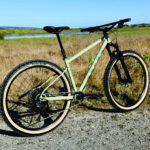It was Memorial Day weekend, and our family joined the throng at a bustling campground, eager for a long weekend immersed in nature. This Oregon gem, like many others, was nestled amidst outdoor adventure hotspots – rock climbing, river tubing, mountain biking, scenic hikes, and trail runs were all on the doorstep. With kids aged 6 and 8, mine are still in the younger bracket. Naturally, parental caution was in full swing. We had the scorpion-under-a-rock lesson, the goathead puncturevine shoe warning, hats on, and sunscreen liberally applied. Just as we were unpacking, a group of slightly older kids, maybe 8 to 10, zipped past on what looked like Lectric XP folding electric bikes.
They were the picture of carefree joy, decked out in downhill mountain biking helmets, and speeding around the campground loop with seemingly reckless abandon, weaving between cars and pedestrians. My children watched them, a mix of longing and quiet resignation in their eyes. We own several ebikes, but our rule is firm: no riding them until they are at least 16. As a parent, witnessing those kids, I felt a renewed conviction in this rule, and it’s a guideline I strongly suggest other parents consider when thinking about Electric Bikes For Kids.
The Heavy Reality of E-bike Accidents
The e-bike world, though relatively niche, was shaken by the tragic death of 12-year-old Molly Steinsapir. In 2021, Molly was riding as a passenger on a Rad Power Bike, driven by her 11-year-old friend, Eme Green. Descending a hill, Eme lost control; the pair crashed at high speed. Despite wearing a helmet, Molly suffered a severe head injury, lost consciousness, and tragically never recovered.
As a parent, recounting this is heart-wrenching. Molly’s parents filed a lawsuit against Rad Power Bikes, arguing the manufacturer bore responsibility. The electric bike industry’s rapid growth has outpaced the development of adequate safety regulations. The numerous e-bike fires in New York City that spurred the push for mandatory UL certification highlight this regulatory lag.
However, with any emerging technology, parental understanding and informed decision-making are paramount, especially when it involves children. Let me be clear: I do not fault Molly’s parents. The unimaginable pain of losing a child is beyond words. Hindsight is always 20/20, and many of us, myself included, have made parenting choices with less severe repercussions than letting a child ride an electric bike.
The Steinsapirs’ lawsuit explicitly stated their lack of awareness regarding the dangers of children riding electric bikes. So, speaking from experience as someone who has tested numerous electric bikes, including the RadRunner – the model involved in the accident – my message is unequivocal: do not allow young children to ride electric bikes. The potential risks far outweigh the perceived benefits when it comes to electric bikes for kids.
Why Electric Bikes and Young Children Don’t Mix
Electric bikes are not simply bicycles with motors. They are heavier, faster, and require different handling skills than traditional bikes. For young children, whose motor skills, reaction times, and judgment are still developing, these differences are significant.
- Weight and Size: Electric bikes are considerably heavier than standard kids’ bikes. This increased weight makes them harder to control, especially for smaller children, and more difficult to manage in emergency situations or when the bike starts to fall.
- Speed and Power: The electric assist allows for much higher speeds than children typically achieve on their own. This increased speed reduces reaction time and increases the severity of potential accidents. Young riders may not be equipped to handle the sudden acceleration and braking power of an e-bike.
- Decision Making: Children’s cognitive development is ongoing. Their ability to assess risks, make quick decisions in traffic or challenging terrains, and understand the consequences of speed and momentum is still maturing. Putting them on a faster, heavier vehicle amplifies these limitations.
While the sight of kids enjoying electric bikes is appealing, prioritizing their safety must be paramount. Consider the developmental stage of your child and the inherent risks associated with these powerful machines. There are many years ahead for them to enjoy e-bikes when they are older and more equipped to handle the responsibility. For now, traditional bikes and scooters offer safer avenues for outdoor fun and exercise for kids.

